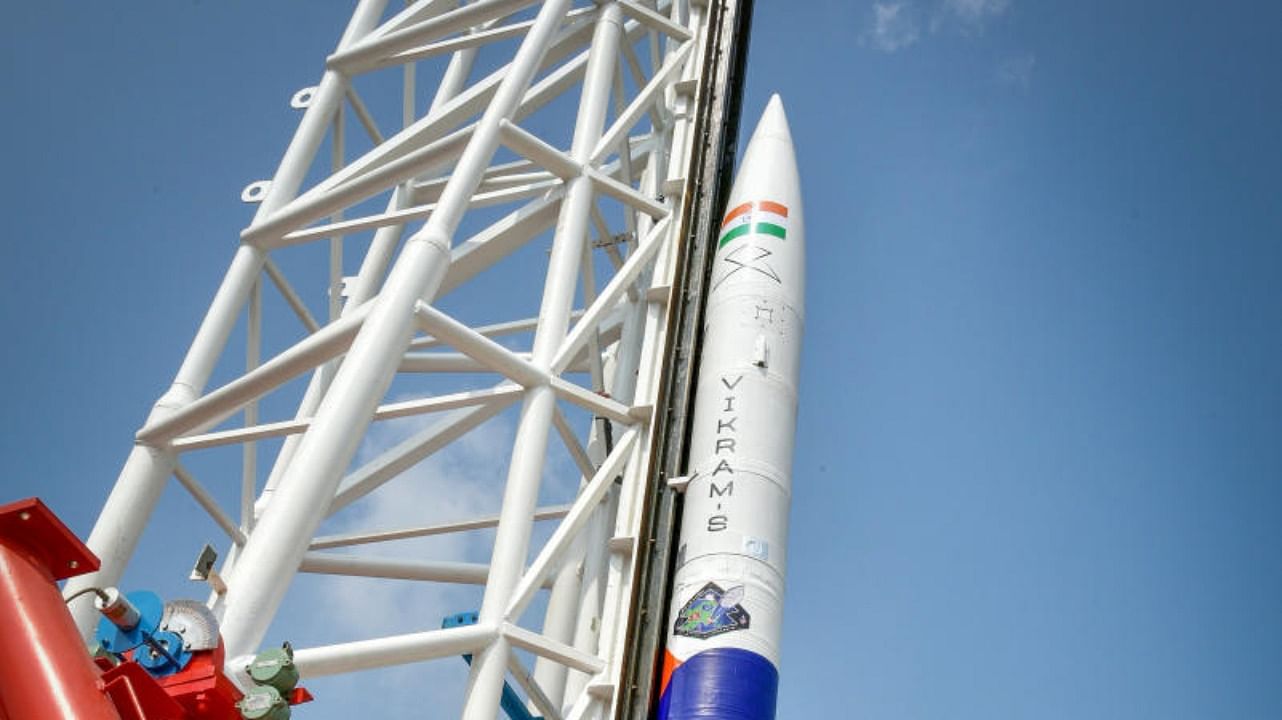
Vikram-S, the country’s first privately built rocket by a Hyderabad-based start-up, soared into the sky from the Indian Space Research Organisation’s (ISRO) spaceport in Sriharikota, in a giant leap for the fledgling private space sector in India.
Vikram-S, named after the founder of the country’s space program, Dr Vikram Sarabhai, blasted off from the Satish Dhawan Space Centre (SDSC) in Sriharikota at 11.30 am. The rocket is a single stage suborbital space launch vehicle of Skyroot Aerospace.
The mission titled ‘Prarambh’ (beginning) carried two domestic payloads built by Space Kidz India and N-Space Tech India and one foreign payload from Bazoomq of Armenia. The successful launch of the mission was a new dawn in India’s space history as this was the first privately-build rocket to be launched after the Union Government opened up the space sector to private players in 2020.
Skyroot Aerospace, the Hyderabad based start-up founded in 2018 by former ISRO scientists Pawan Kumar Chandana and Naga Bharath Daka, built the rocket, Vikram-S, in two years using advanced technologies like carbon composite structures and 3D-printed components.
“I am happy to announce the successful completion of Mission ‘Prarambh’ of Skyroot Aerospace,” Pawan K Goenka, Chairman of Indian National Space Promotion and Authorization Center (IN-SPACe) announced at the Mission Control Centre in SDSC.
“The rocket VKS took off and achieved an altitude of 89.5 km and a range 121.2 km. This was exactly what was planned. All systems, as I can make out, work as planned, and Skyroot Aerospace has demonstrated capability of various sub-systems that will go into a orbital launch vehicle,” Goenka added.
Pawan Kumar Chandana, co-founder, Skyroot Aerospace, said Vikram-S rocket met all flight parameters and achieved peak altitude of 89.5 kms.
"This is a small step by a start-up and a giant leap for the Indian space industry. It is the beginning go a new era in the Indian space ecosystem and the launch symbolises potential of new India. This is just the beginning of great future,” he added.
Union Minister for Science and Technology Dr Jitendra Singh, who was present for the launch, said the mission was “indeed a new beginning and a new dawn” in the journey of India’s space programme.
“It is a major step forward in India developing its own space ecosystem. And of course, it is a turning point in India’s start-up movement. Well done everyone,” he added.
The rocket, which boasts of cutting- edge avionics and all-carbon fibre core structure, is powered by solid-fuelled propulsion and weights 545 kg. It is 6 metre long, and 0.375 metres in diameter.
Pitching Vikram series as the “quickest and most affordable” way to reach space, the start-up said Friday’s launch will help test and validate majority of the technologies in the Vikram series of orbital class space launch vehicles, including many sub-systems and technologies that will be tested across pre-lift-off and post-lift-off phases of the launch.
The company said named after Dr. Vikram Sarabhai, founder of the Indian Space Program – Vikram is a series of modular Space launch vehicles especially crafted for the small satellite market.
It also plans to launch 20,000 small satellites in the coming decade, and that the leading technology architecture of Vikram vehicles offers unique capabilities like multi orbit insertion, interplanetary missions; while providing customized, dedicated and ride share options covering a wide spectrum of small satellite customer needs.
Some of the salient features of the rocket are it is one of the world’s first few all composite space launch vehicles, 3D printed solid thrusters for spin stability, and tests 80 per cent of tech for future Vikram series of orbital space vehicles.